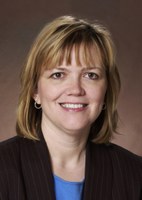Prairie Fare: Have Your Blood Pressure Checked
(Click the image below to view a high-resolution image that can be downloaded)
By Julie Garden-Robinson, Nutrition Specialist
NDSU Extension Service
Have you been checked with a sphygmomanometer lately?
The name of the device sounds a bit like a creation of Dr. Seuss, perhaps something the “Cat in the Hat” would arrive with at the end of the story to save the day.
Actually, a sphygmomanometer could save your life. It’s a device used to measure blood pressure in millimeters of mercury (mmHg).
According to the Centers for Disease Control and Prevention (CDC), about one of three Americans has high blood pressure. Since high blood pressure has no warning signs, it sometimes is referred to as the “silent killer.”
High blood pressure is a risk factor for heart disease, stroke, heart failure, kidney disease and eye damage that could lead to blindness.
A blood pressure reading consists of two numbers. The top number is systolic pressure, the pressure while the heart is beating. The lower number is diastolic pressure, the pressure while the heart is relaxing. Health experts have defined three categories:
- Normal blood pressure is defined as a blood pressure reading of less than 120 over less than 80.
- Prehypertension is defined as a systolic blood pressure reading of 120 to 139 mmHg and a diastolic reading of 80 to 89 mmHg.
- High blood pressure or hypertension is defined as a systolic blood pressure reading of 140 mmHg or higher and a diastolic reading of 90 mmHg or higher.
Don’t be among the people who do not know they have high blood pressure. Have your blood pressure checked.
If you learn that you have high blood pressure, you may or may not need medication. Sometimes blood pressure can be managed with lifestyle changes. Discuss these suggestions based on CDC recommendations with your health-care provider.
- Maintain a healthy weight. If you’re overweight, losing weight often helps lower blood pressure. Work with a health-care professional to define a healthy weight for you. Visit http://www.mypyramid.gov for information about a healthy diet, including personalized plans that could help with weight management.
- Get more active. Aim for at least 30 minutes of moderate physical activity on five or more days of the week. Be enticed by the warmer spring weather to put on some walking shoes and explore the outdoors.
- Pay attention to your sodium intake. Many people consume at least twice the sodium recommendation. Pay attention to the sodium information on Nutrition Facts labels. For example, a serving of some types of soups contains half the daily sodium recommendation. Try eating fewer processed foods, such as boxed dinners and canned soups. Flavor your foods with sodium-free herbs and spices. Leave the salt shaker in the cupboard.
- Pay attention to your potassium intake. Many people do not get enough of this important mineral. Potassium is found in foods such as potatoes, bananas, spinach and other leafy greens, apricots, oranges, nuts, legumes and dairy products.
- Check out the recommendations in the DASH diet (short for Dietary Approaches to Stop Hypertension). This eating plan has been shown to be effective in lowering high blood pressure. A free DASH publication with recipes, menus and other information is online from the National Institutes of Health at http://www.nhlbi.nih.gov/health/public/heart/hbp/dash/new_dash.pdf.
Here’s a quick, healthful recipe to enjoy. You’ve heard what they say about an apple a day!
Apple Salad
2 c. diced apples
1 c. diced celery
1/2 c. raisins
1/2 c. nuts, chopped
2 Tbsp. salad dressing or mayonnaise
1 Tbsp. orange juice
Mix orange juice with salad dressing or mayonnaise. Toss apples, celery, raisins and nuts with the dressing mixture.
Makes eight servings. Each serving has 110 calories, 6 grams (g) of fat, 15 g of carbohydrate, 2 g of fiber and 45 milligrams of sodium.
(Julie Garden-Robinson, Ph.D., L.R.D., is a North Dakota State University Extension Service food and nutrition specialist and associate professor in the Department of Health, Nutrition and Exercise Sciences.)
NDSU Agriculture Communication
| Source: | Julie Garden-Robinson, (701) 231-7187, julie.garden-robinson@ndsu.edu |
|---|---|
| Editor: | Rich Mattern, (701) 231-6136, richard.mattern@ndsu.edu |


